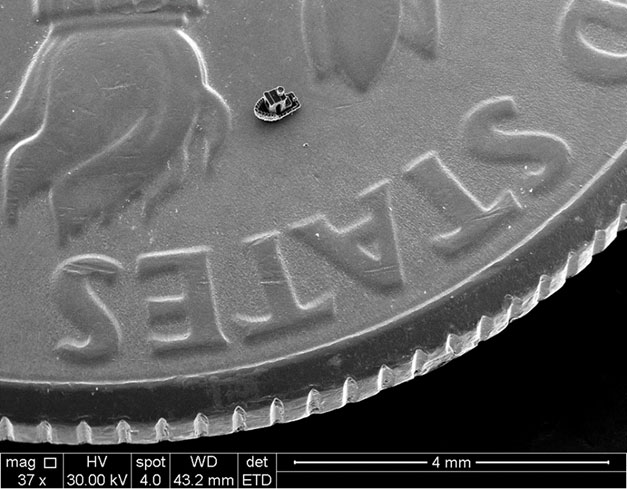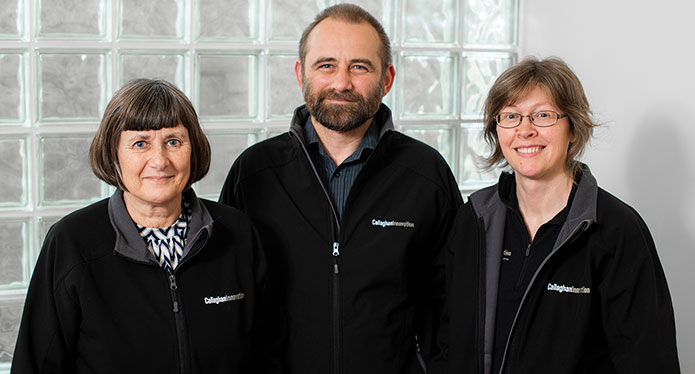Callaghan Innovation – breakthrough research in the manufacture of tiny sensors
Andrea Bubendorfer is a Principal Research Scientist and Microfabrication Team Leader at Callaghan Innovation. Her team’s MicroMaker project: scalable, rapid-printing technology that creates tiny devices, opens the way for New Zealand companies to take the lead in a multi-billion dollar global industry.
On this page
'Benchy' the tugboat, approximately the size of a grain of sand, sitting on a US dime

1:100th scale replica of ‘Benchy’ – the 3D printing benchmark “torture test”
Tiny sensors, big potential
The miniaturisation trend has changed the way we live. The myriad of miniaturised sensors behind the Internet of Things (everything connected to the Internet) provides security, saves lives and improves our quality of life. And in space, where miniaturised sensors are used for advanced farming, manufacturing and health, they’re bringing space technology to the real world, dramatically transforming our everyday lives.
As more and more areas of life are digitalised, especially in the age of Covid-19, the demand for innovative sensor technologies will continue to grow.
Faster, cheaper technology
Until now few New Zealand companies could afford to be part of the miniaturisation industry due to the cost of expensive cleanroom equipment and infrastructure. Co-inventors Andrew Best and Andrea Bubendorfer are quietly changing all that with Micromaker, scalable, rapid-print technology that simplifies the manufacturing process and significantly reduces cost.
“We’ve got complex cleanroom techniques to a point where the whole process is automatable and can fit into a desktop box, so it’s faster, cheaper and more portable than traditional methods of miniaturisation,” said Ms Bubendorfer.
Perfect for space applications
MicroMaker is capable of making very small and extremely light devices, which makes it the perfect technology for space applications, where every single, last gram matters.
Being able to manufacture components on site, eliminates the need to take extra equipment on board — and being able to create more than one prototype means you can adjust the process until you have something that is absolutely fit for purpose.
As well as sensors for satellites and experiments in microgravity, the MicroMaker could, in the future, be used in real-time experiments in space, for example, on the International Space Station, or one day on the moon or even Mars!
Opportunities in the age of Covid
It seems inevitable that Covid -19 will create opportunities for more varied types of sensors. For example, voice-activated devices that avoid the need for touchscreens; tiny microphones or haptic sensors that detect motion and gestures; and proximity sensors that alert users to distances between people or devices; as well as sensors for faster medical testing.
The MicroMaker team’s breakthrough research could mean that smaller New Zealand companies have the potential to be agile and responsive to these new opportunities, creating new markets and more jobs.
More about Micromaker miniaturisation technology on the Callaghan Innovation website(external link)
Award winning technology
Winner ENVIS Engineering Innovation award 2019 from Engineering New Zealand
A breathtakingly clever engineering project or product that has solved an age-old problem or shifted from the ‘always done this way’ mentality.
One of 3 finalists in the 2019 KiwiNet Research commercialisation awards, celebrating transforming scientific discoveries into new business.
One of 6 winners in the international RadLaunch Class of 2019, accelerator for UV+EB start-ups, students & innovators.
One of 10 winners of the international IDTechEx! Show Launchpad 2018, an initiative selecting applicants demonstrating a world-class emerging technology for 3D printing, electric vehicles, energy storage, graphene, internet of things, printed electronics, sensors or wearable technology
KiwiNet Emerging Innovator award 2016, a programme to discover, inspire and nurture Kiwi scientists with entrepreneurial DNA, fast-tracking them to commercial success.

Some of the MicroMaker3D Team - Ann Manning, Andrew Best and Andrea Bubendorfer.

